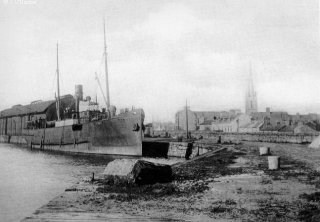The Ulster emigration of the eighteenth century was, as we noted earlier, almost continuous from 1717 onwards. Much of that first wave (1717-18) was organised by Presbyterian ministers. Their people suffered from increasing rents, which saw the iniquitous tithes
(payable to the Established Church only) increase proportionately. Dean Swift (1720) said, ‘The screwing and racking of rents has reduced the people to worse conditions than vassals in Poland‘.
They were also subject to the Sacramental Test of 1704. A succession of bad harvests (1725-28) increased poverty and death levels and a severe famine struck in 1741. Conditions came to a head in the early 1770s with growing demand for land and the spread of the system of ‘canting’ – auctioning tenancies; and the increasing tendency to lease land to middle men. This gave rise to violent agrarian groups such as the Hearts of Steel.
The collapse of the Linen Trade (1772-1773) – with the sudden decline in foreign demand – produced distress throughout Ulster. Arthur Young believed that all of the 30,000 people said to have emigrated in these two years were linen weavers.
Also there was the growing attraction of America, highlighted from emigrants’ letters home, from promotional actions of the part of agents and ships’ captains and from the inducements offered by land promoters.
Vessels designed to carry flaxseed and potash from the colonies carried emigrants on the return journey. Ship-owners often took more passengers than their ships could comfortably accommodate. This and inadequate provisions often resulted in fever, sickness and death.
Emigration from Ulster halted temporarily in the summer of 1775 with the news of fighting at Lexington and Concorde but resumed before the American Revolution was over in 1783. In the 1780s and 1790s Ulster emigration averaged 5,000 people annually. Large numbers left after the failure of the ’98 Rebellion. By 1800 the servant trade had almost ended and most passengers were now fare-paying.
Patterns fluctuated during the Napoleonic Wars. In 1811 emigration again exceeded 5,000 per year. But a new hazard appeared. British warships often impressed manpower on the high seas. For example in May 1812 (Anglo-American War days, as well as Napoleonic Wars) 150 emigrants were impressed from vessels lying at anchor in Moville Bay.
Ulster emigration in the years 1815-1845 amounted to some half a million people. This Post-1815 haemorrhage was due to several factors: mounting population pressure and intensified competition for land; the decline of Irish agriculture (grain prices collapsed at the end of the war and continued under the English-inspired Acts that led to amalgamation and clearance of estates to help the switch from arable to pasture); unfair incentives for English as against Irish industries; reduced trans-Atlantic fares; the increased Canadian timber trade that brought transit-passengers intending to travel on, overland into America; and finally the growth of pre-paid passages (many paid for in the United States).
There also was a growth in this period of Catholic and Church of Ireland emigrants. During the latter years of the Great Famine the numbers increased but many were destitute people. In the period 1851-1899 about one million emigrated from Ulster for all destinations, while 3.8m left Ireland in total. Even in the 1880s and 1890s, Ulster accounted for as much as 20% of all Irish emigration.
… Abbey of Viridium Lignum …
